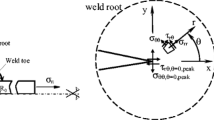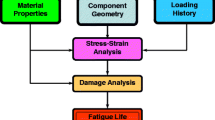Abstract
The Peak Stress Method (PSM) has been presented in some previous papers, where it was shown that, in plane problems, the singular elastic maximum principal stress, evaluated at the weld toe of fillet-welded joints by means of a finite element analysis, is proportional to the Mode I Notch Stress Intensity Factor (NSIF), In parallel, a model based on the mean value of the strain energy (SED) averaged in a properly defined structural volume surrounding the point of fatigue crack initiation (either the weld toe or the weld root) has been proposed for fatigue strength assessments. The local strain energy values were given as a function of the Mode I and Mode II NSIFs neglecting the influence of the higher order (non-singular) stress terms. In the present work an expression linking the peak stress and the local strain energy value is presented, which can be used in plane problems when Mode II stress fields are non singular (at the weld toe) or of low intensity (at the weld root), By so doing, a single design scatter band valid for either weld root failures or weld toe failures can be calibrated in terms of elastic peak stress evaluated at the critical point.
Similar content being viewed by others
References
Williams M.L.: Stress singularities resulting from various boundary conditions in angular corners on plates in tension, Journal of Applied Mechanics, 1952, vol. 19, pp. 526–528.
Gross R. and Mendelson A.: Plane elastostatic analysis of V-notched plates, International Journal of Fracture Mechanics, 1972, vol. 8, no. 3, pp. 267–276.
Lazzarin P. and Tovo R.: A unified approach to the evaluation of linear elastic fields in the neighbourhood of cracks and notches, International Journal of Fracture, 1996, vol. 78, no. 1, pp. 3–19.
Lazzarin P. and Tovo R.: A notch intensity factor approach to the stress analysis of welds, Fatigue and Fracture of Engineering Materials and Structures, 1998, vol. 21, no. 9, pp. 1089–1103.
Lazzarin P. and Livieri P.: Notch stress intensity factors and fatigue strength of aluminium and steel welded joints, International Journal of Fatigue, 2001, vol. 23, no. 3, pp. 225–232.
Lazzarin P., Sonsino C.M. and Zambardi R.: A notch stress intensity approach to predict the fatigue behaviour of T butt welds between tube and flange when subjected to in-phase bending and torsion loading, Fatigue and Fracture of Engineering Materials and Structures, 2004, vol. 27, no. 2, pp. 127–141.
Lazzarin P. and Zambardi R.: A finite-volume-energy based approach to predict the static and fatigue behaviour of components with sharp V-shaped notches, International Journal of Fracture, 2001, vol. 112, no. 3, pp. 275–298.
Lazzarin P., Lassen T. and Livieri P.: A Notch Stress Intensity approach applied to fatigue life predictions of welded joints with different local toe geometry, Fatigue and Fracture of Engineering Materials and Structures, 2003, vol. 26, no. 1, pp. 49–58.
Livieri P. and Lazzarin P.: Fatigue strength of steel and aluminium welded joints based on generalised stress intensity factors and local strain energy values, International Journal of Fracture, 2005, vol. 133, no. 3, pp. 247–276.
Lazzarin P., Berto F. and Radaj D.: Fatigue-relevant stress field parameters of welded lap joints: pointed slit tip versus keyhole notch, Fatigue and Fracture of Engineering Materials and Structures, 2009, vol. 32, no. 9, pp. 713–735.
Fricke W. and Feltz O.: Fatigue tests and numerical analyses of partial-load and full-load carrying fillet welds at cover plates and lap joints, Doc. IIW-2080, Welding in the World, 2010, vol. 54, no. 7/8, pp. R225–233.
Fischer C., Feltz O., Fricke W. and Lazzarin P.: Application of the notch stress intensity and crack propagation approaches to weld toe and root fatigue, Doc. IIW-2206, Welding in the World, 2011, vol. 55, no. 7/8, pp. 30–39.
Radaj D., Berto F. and Lazzarin P.: Local fatigue strength parameters for welded joints based on strain energy density with inclusion of small-size notches, Engineering Fracture Mechanics, 2009, vol. 76, no. 8, pp. 1109–1130.
Radaj D., Lazzarin P. and Berto F.: Fatigue assessment of welded joints under slit-parallel loading based on strain energy density or notch rounding, International Journal of Fatigue, 2009, vol. 31, no. 10, pp. 1490–1504.
Lazzarin P., Berto F. and Radaj D.: Uniform fatigue strength of butt and fillet welded joints in terms of the local strain energy density, Proceedings of 9th International Fatigue Conference IFC9, 2006, Atlanta, USA.
Lazzarin P., Berto F., Gomez F.J. and Zappalorto M.: Some advantages derived from the use of the strain energy density over a control volume in fatigue strength assessments of welded joints, International Journal of Fatigue, 2008, vol. 30, no. 8, pp. 1345–1357.
Lazzarin P., Berto F. and Zappalorto M.: Rapid calculations of notch stress intensity factors based on averaged strain energy density from coarse meshes: Theoretical bases and applications, International Journal of Fatigue, 2010, vol. 32, no. 10, pp. 1559–1567.
Atzori B., Lazzarin P. and Meneghetti G.: Fatigue strength of welded joints based on local, semi-local and nominal approaches, Theoretical and Applied Fracture Mechanics, 2009, vol. 52, no. 1, pp. 55–61.
Meneghetti G. and Lazzarin P.: Significance of the elastic peak stress evaluated by FE analyses at the point of singularity of sharp V-notched components, Fatigue and Fracture of Engineering Materials and Structures, 2007, vol. 30, no. 2, pp. 95–106.
Haibach E.: Service fatigue-strength-methods and data for structural analysis, 1989, VDI, Dusseldorf.
Meneghetti G.: The peak stress method applied to fatigue assessments of steel and aluminium fillet welded joints subjected to mode-I loading, Fatigue and Fracture of Engineering Materials and Structures, 2008, vol. 31, no. 5, pp. 346–369.
Lazzarin P., Meneghetti G., Berto F. and Zappalorto M.: Practical application of the N-SIF approach in fatigue strength assessment of welded joints, Doc. IIW-1981, Welding in the World, 2009, vol. 53, no. 3/4, pp. R76–R89.
Balasubramanian V. and Guha B.: Optimising the shielded metal arc welded cruciform joint dimensions of ASTM 517 F grade steels containing LOP defects, International Journal of Pressure Vessels and Piping, 1999, vol. 76, no. 3, pp. 147–155.
Balasubramanian V. and Guha B.: Influence of flux cored arc welded cruciform joint dimensions on fatigue life of ASTM 517 ‘F’ grade steels, International Journal of Pressure Vessels and Piping, 1998, vol. 75, no. 10, pp. 765–772.
Balasubramanian V. and Guha B.: Fatigue life prediction of shielded metal arc welded cruciform joints containing LOP defects by a mathematical model, International Journal of Pressure Vessels and Piping, 1999, vol. 76, no. 5, pp. 283–290.
Infante V., Branco C.M. and Martins R.: A fracture mechanics analysis on the fatigue behaviour of cruciform joints of duplex stainless steel, Fatigue and Fracture Engineering Materials and Structures, 2003, vol. 26, no. 9, pp. 791–810.
Singh P.J., Achar D.R.G., Guha B. and Nordberg H.: Fatigue life prediction of gas tungsten arc welded AISI 304L cruciform joints with different LOP sizes, International Journal of Fatigue, 2003, vol. 25, no. 1, pp. 1–7.
Singh P.J., Guha B. and Achar D.R.G.: Fatigue life improvement of AISI 304 L cruciform welded joints by cryogenic treatment, Engineering Failure Analysis, 2003, vol. 10, no. 1, pp. 1–12.
Guha B.: A new fracture mechanics method to predict the fatigue life of welded cruciform joints, Engineering Fracture Mechanics, 1995, vol. 52, no. 2, pp. 215–229.
Yamaguchi I., Terada Y. and Nitta A.: On the fatigue strength of steels for ship structures, IIW Doc. XIII-425-66, 1966.
Ouchida H. and Nishioka A.: A study of fatigue strength of fillet welded joints, IIW Doc. XIII-338-64, 1964.
Macfarlane D.S. and Harrison J.D.: Some fatigue tests of load carrying transverse fillet welds, British Welding Journal, 1965, vol. 12, no. 12, pp.613–623.
Radaj D.: Design and analysis of fatigue resistant welded structures, 1990, A ington Publishing, Cambridge.
Author information
Authors and Affiliations
Corresponding author
Rights and permissions
About this article
Cite this article
Meneghetti, G., Lazzarin, P. The Peak Stress Method for Fatigue Strength Assessment of welded joints with weld toe or weld root failures. Weld World 55, 22–29 (2011). https://doi.org/10.1007/BF03321304
Published:
Issue Date:
DOI: https://doi.org/10.1007/BF03321304




